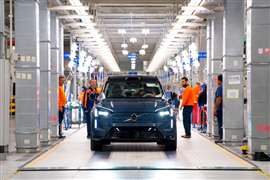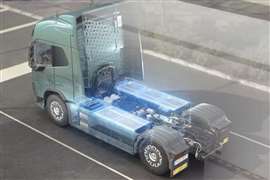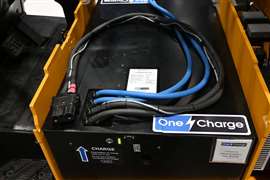Read this article in Français Deutsch Italiano Português Español
Circulor discusses digital battery passports
02 September 2024
In accordance with EU Regulation 2023/1542, all rechargeable batteries in the region that have capacities greater than 2 kWh and classified as industrial, electric vehicle and light means of transport (LMT) will require digital battery passports effective Feb. 18, 2027.
In July, Volvo Cars appeared to be significantly ahead of that schedule when it launched the first commercially available battery passport on its EX90 SUV. The passport was developed in partnership with UK-based Circulor, a company that uses blockchain technology to map supply chains.
Jessica Green, public affairs and strategy manager at Circulor, said it was a project that took a significant amount of time.
“We’ve been working with Volvo since 2018,” she said. “So, I think that gives some kind of concept of the amount of time it takes to actually trace the critical minerals in these batteries and to engage the suppliers.”
Green added that for compliant, production-scale battery passports, the necessary data comes in large volumes on an ongoing basis.
“What Volvo has achieved is significant, because it’s the material traceability of the critical minerals,” she said. “It’s the carbon emissions of the battery, per battery — not just on a general batch level — as well as proving the recycled content.”
Timeline and Concerns
According to Green, all these data are separate requirements of the battery regulation itself that becomes more stringent over time.
“So, August 2025, the economic operators have to prove due diligence and implement traceability for critical mineral supply chains — cobalt, nickel, lithium and graphite — and then they have to declare the carbon footprint of their batteries. Then the recycled content requirements come in. And then February 2027 — that’s when the battery passports come into force.”
While gathering and organizing this data into a coherent battery passport is a significant hurdle, Green said other challenges include the sharing of data and concerns about sharing — or having to share — too much.
“In this day and age, radical transparency is needed in order to achieve the climate goals that we collectively, globally, have to achieve,” Green said.
However, the battery passport is designed to enable the secure collation of data, with sharing of data coupled to different categories of stakeholders.
“As a consumer, you and I wouldn’t get the same information as a remanufacturer, for example,” Green said, “or we wouldn’t get the same information as a regulator and auditor.”
Controlling those different access levels is something Circulor is working through with customers and policymakers in Europe, Green said.
Nonetheless, she said the milestone achieved by Volvo Cars and the progress made by others regarding battery passports are to be celebrated.
“There are a lot of other automakers, their tier ones and their supply chains — all the way through to the upstream mining, refining organizations and the recyclers — that understand the benefits of traceability and digital identifiers or battery passports, depending upon what region you’re in, as a compliance tool,” Green said. “But also, the opportunities that it brings in terms of proving and responsible sourcing of the supply chain.”
Green added that those opportunities include more regional sourcing of materials, closed-loop recycling and the decarbonization of supply chains.
Planning for Compliance
With February 2027 still a couple of years away, some manufacturers may only now be looking into what they have to do to comply with the forthcoming EU regulation. Green said work like that completed by Circulor and Volvo Cars can serve as a “lighthouse project.”
 The EX90 SUV from Volvo Cars, with the first commercially available battery passport. (Photo: Volvo Cars)
The EX90 SUV from Volvo Cars, with the first commercially available battery passport. (Photo: Volvo Cars)
“There’s education around it now,” she said. “Everyone understands traceability and battery passports and the concept of this and that they are required to do it. So, actually looking at some of the pioneers, the leaders in this space that have made great progress already, can facilitate that much more quickly for them.”
Circulor’s work on battery passports has allowed the company to develop a reliable process for working with new customers.
“We would onboard the OEMs themselves and their tier ones — largely who we are already working with — and then map their supply chains and onboard each of the individual suppliers all the way back to source and having that end-to-end traceability,” she said. “Working with the upstream mining organizations all the way through as well as increasing numbers of recyclers on our platform.”
Gathering Data
Once the onboarding is complete, Green said Circulor has a variety of approaches to begin gathering data. For example, it can be done through APIs from each supplier’s existing systems or via Circulor’s mobile application.
“IoT (internet of things) devices, location tracking, facial recognition [and] geofencing are used to input the data onto our platform,” she said.
Green said that Circulor already has more than 150 facilities across the battery value chain on its platform.
“For new OEMs coming to work with us, the likelihood is we’ll already have some of their suppliers on our platform who are working with us and providing us data for their other customers.”
Working on an effective battery passport project requires collaboration among a number of key stakeholders within an organization.
“It’s a C-suite-level discussion,” Green said. “And I would also say it remains that, but it’s also changed.”
She added, “It includes operations. You know, getting QR codes with a battery passport action on the vehicle, in the production plants. Educating the workforce about what’s going on. Dealerships — educating them on what’s going on. Marketing, in terms of sharing the sustainability impacts, and also educating them on what a battery passport is.”
Other OEM teams include procurement and compliance, “because regulations are either dangling a carrot or a stick, depending on if you’re in Europe or the U.S.,” she said.
Finally, Green noted that chief financial officers (CFO) and their staffs must be involved in the effort “in terms of their bottom line and quantifying some of their sustainability impacts.”
POWER SOURCING GUIDE
The trusted reference and buyer’s guide for 83 years
The original “desktop search engine,” guiding nearly 10,000 users in more than 90 countries it is the primary reference for specifications and details on all the components that go into engine systems.
Visit Now
STAY CONNECTED




Receive the information you need when you need it through our world-leading magazines, newsletters and daily briefings.
CONNECT WITH THE TEAM
















